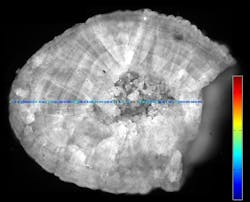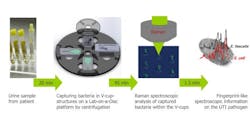Raman spectroscopy method can analyze kidney stones rapidly
Fraunhofer Institute for Physical Measurement Techniques (IPM; Freiburg, Germany) researchers and colleagues are developing a Raman spectroscopy system for rapid analysis of kidney stones immediately after the surgical procedure.
Related Article
Kidney stones are often no larger than a grain of rice, yet some can grow to measure several centimeters in diameter. Sometimes, a kidney stone might block the ureter, causing colic pain in the flank. If it cannot be dissolved, the kidney stone is treated using extracorporeal shock-wave therapy or by applying minimally invasive endoscopic modalities.
Many patients suffer from disease recurrence and need retreatments. Scientific studies have shown that new stone formation might be reduced by 50% if individualized follow-up care and proper metaphylaxis measures are offered to the patient. Recommendations regarding dietary habits or the use of particular medication strategies are based on the knowledge of stone composition. In collaboration with an industrial partner and the Division of Urotechnology at University Medical Center Freiburg, the Fraunhofer IPM researchers are developing a novel Raman spectroscopy-based diagnostic system for rapid and automated analysis of kidney stones, thus significantly improving patient follow-up care after stone treatment. The researchers in this project are working with urologists specialized in modern methods of treating kidney stone disease.
Conventional kidney stone analysis technologies such as infrared (IR) spectroscopy are costly and time-consuming, including preparation of stone samples. Analysis can also only be performed in a dedicated laboratory facility and because only a few centers offer this type of analysis, it can take up to three weeks to receive results. “The patient in most cases has already been discharged and will not be seeing the doctor again. We advise stone patients to drink plenty of fluids, increase physical activities, and lose weight if necessary. Unfortunately, this is only a general recommendation. From the clinical point of view, we need individualized approaches and these must include results of a compositional analysis of the stone. This allows us to evaluate the individual risk of disease recurrence and detect potential metabolic abnormalities,” says Fraunhofer IPM physician and researcher Dr. Arkadiusz Miernik, who is leading the work.
Raman spectroscopy is allowing Miernik and his team to rapidly characterize and conclusively identify specific kidney stone types. The method uses a characteristic spectrum in the visible wavelength range of the examined sample called a chemical fingerprint, and samples are illuminated using laser light. "About 1% of the photons are reflected back in a different wave spectrum highly specific to the sample. We record these signals in a database,” explains Miernik. Then, the researchers use computer software to filter out the fluorescent background occuring during Raman spectroscopy using computer software.
This method employs relatively inexpensive optical components, and it also works on wet, unprepared samples. The time taken to prepare specimens is substantially reduced. “The stones previously had to be dried and pulverized prior to analysis. Our system makes this unnecessary. Stone fragments collected during the surgical procedure do not need to be further processed. They can in principle be put directly into the Raman spectrometer for analysis,” explains Miernik. Currently, there are a few specialized laboratories that can carry out this procedure using large-scale analytical equipment. A compact device suitable for use in a clinical setting and allowing immediate, post-interventional automated analysis is not yet available.
A demonstration system, including the hardware and software required for stone analysis developed by the researchers, already exists as a prototype. This prototype must first be made more compact before it is ready for the market. A unique feature of the system is its spectral database: an information index has been built up of data on the nine pure substances making up 99% of kidney stones. The researchers examined nearly 160 kidney stone samples in setting up the software during the first validation phase. Moreover, the results were confirmed after a conventional IR-based analysis in a reference laboratory. “Once the complete system is ready for clinical use, the physician (urologist) will be able to examine stone samples directly after surgical intervention on his own, thus increasing the quality of patients’ care substantially,” says Miernik.
For more information, please visit www.fraunhofer.de.

